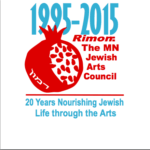P’Chotchka is Rimon: the Minnesota Jewish Art Council’s annual gala on Monday, June 6, at the Metropolitan Ballroom starting at 6 p.m. The eight honorees, whose works have been featured by Rimon over the past five years, will pick their favorite images and talk about what those images mean to them. But they have to talk quick because the clock is moving.
This year’s artists are: Alan Berks (playwright), Rachel Breen (visual artist), Joel Carter (artist/storyteller) Joyce Lyon (visual artist), Lynda Monick-Isenberg (artist/educator), Alison Morse (writer), Izzy Rousmaniere (writer) and David Sherman (photographer).
David Harris, the executive director of Rimon, said that the format comes from the Japanese word “Pecha Kucha,” which means chit-chat.
“It’s a very fast-paced and very effective way to get insight into an artist’s work,” Harris said. “Time stops for no one. The images move automatically and the presenter can’t stop them. It’s like small, artistic autobiographies. For some it’s their work and their roots. For others, it’s who they are as a person and how they relate to the community.”
Keeping with the numerical theme of 18 is Rousmaniere, an 18-year-old recent graduate from Minneapolis South High School. Although she began her artistic journey as a writer, the theater is where she finds herself most often. At South, she acted in both scripted and devised theater pieces and, most recently, directed “The Diary of Anne Frank.”
“It’s very daunting,” Izzy said. “There’s room for interpretation but not the unexpected. I have to plan very well and know how it’s going to go. It’s really exciting to explore this new presentation style.”
Izzy said she’ll be picking images that tell her story both as an artist, as well as art she admires. On the other hand Rachel Breen and Alison Morse will be picking photos from their trip to Bangladesh. She said via FaceTime from her vacation in Otricoli, Italy, that she thinks it will be pretty easy to put their presentation together.
“Part of the challenge for us is how do we make work that interacts with each others’ work,” said Breen, who was visiting fellow P’Chotchka honoree Joyce Lyon, a recently retired University of Minnesota art professor.
Breen – who was one of the founders of Jewish Community Action – and Morse had written a blog that chronicled their trip to Bangladesh, which came in the after the Rana Plaza factory collapsed in Dhaka, Bangladesh.
“As soon as we heard that the carelessly constructed factory crumbled and killed over a thousand of the mostly poor, mostly female garment workers who labored inside it, we thought of the Triangle Shirtwaist factory fire of 1911,” they wrote. “The fire in this New York City garment factory, sparked by terrible working conditions and unregulated building codes, killed nearly two hundred mostly young, poor, female immigrant garment workers. Connections between the two events ignited our horror and imaginations. Rachel created visual art; Alison wrote poetry.”
Breen said the link between social justice and art are, for her, inseparable.
“I think about social justice as a lens through which I see the world. I think that’s very much about being Jewish,” she said. “They are so interlinked I don’t even separate them. Anything I do will be connected by, inspired by, motivated by, thinking or acting about that. In doing, art, I don’t think I could do without social justice.
The P’Chotchka experience, Harris said, is about having artists of many experience levels.
“Our message is that Rimon recognizes the full arc of an artists’ life,” he said. “Our effort is to impact the broadest spectrum we can vis-a-vis the arts.”



